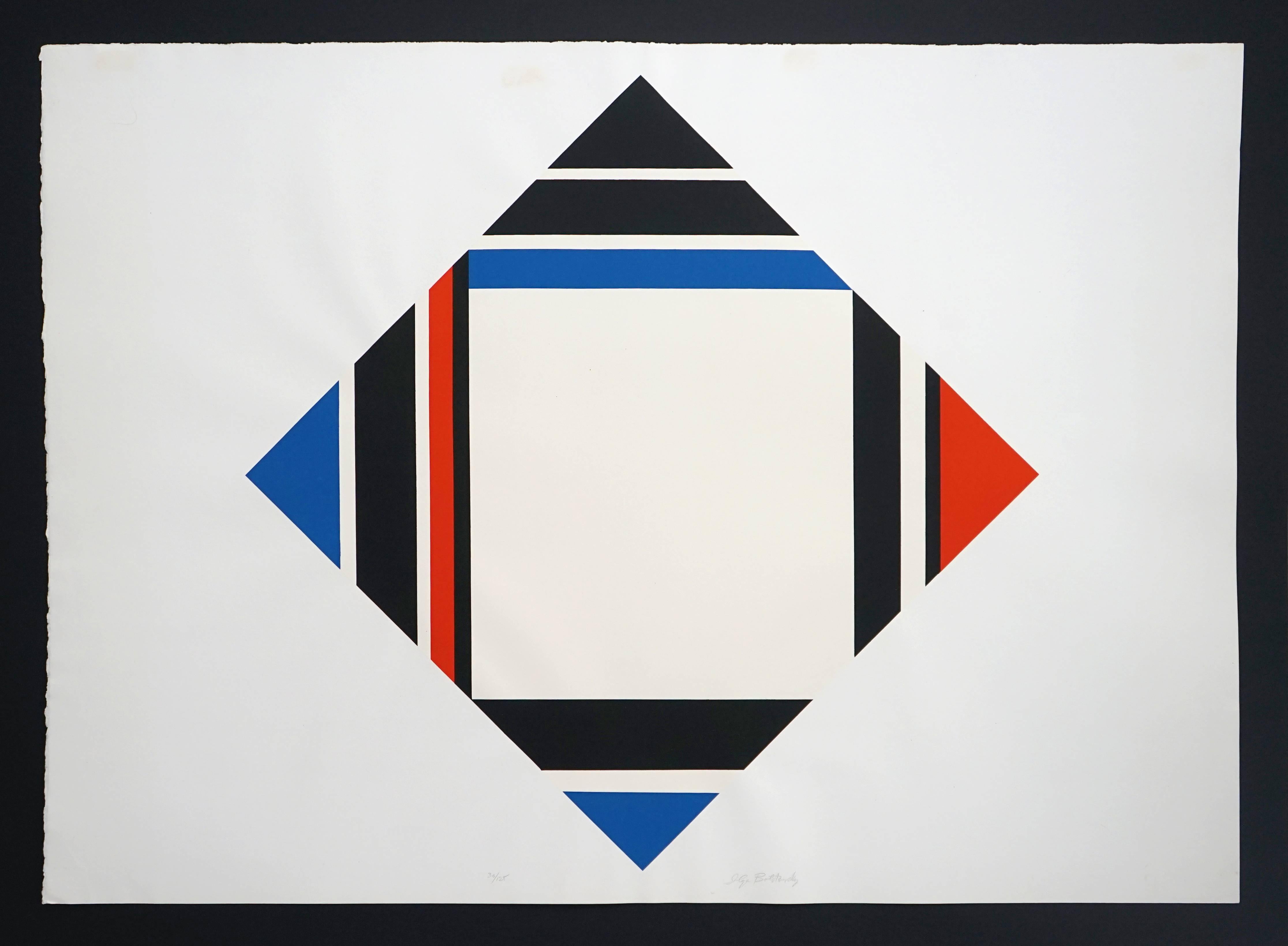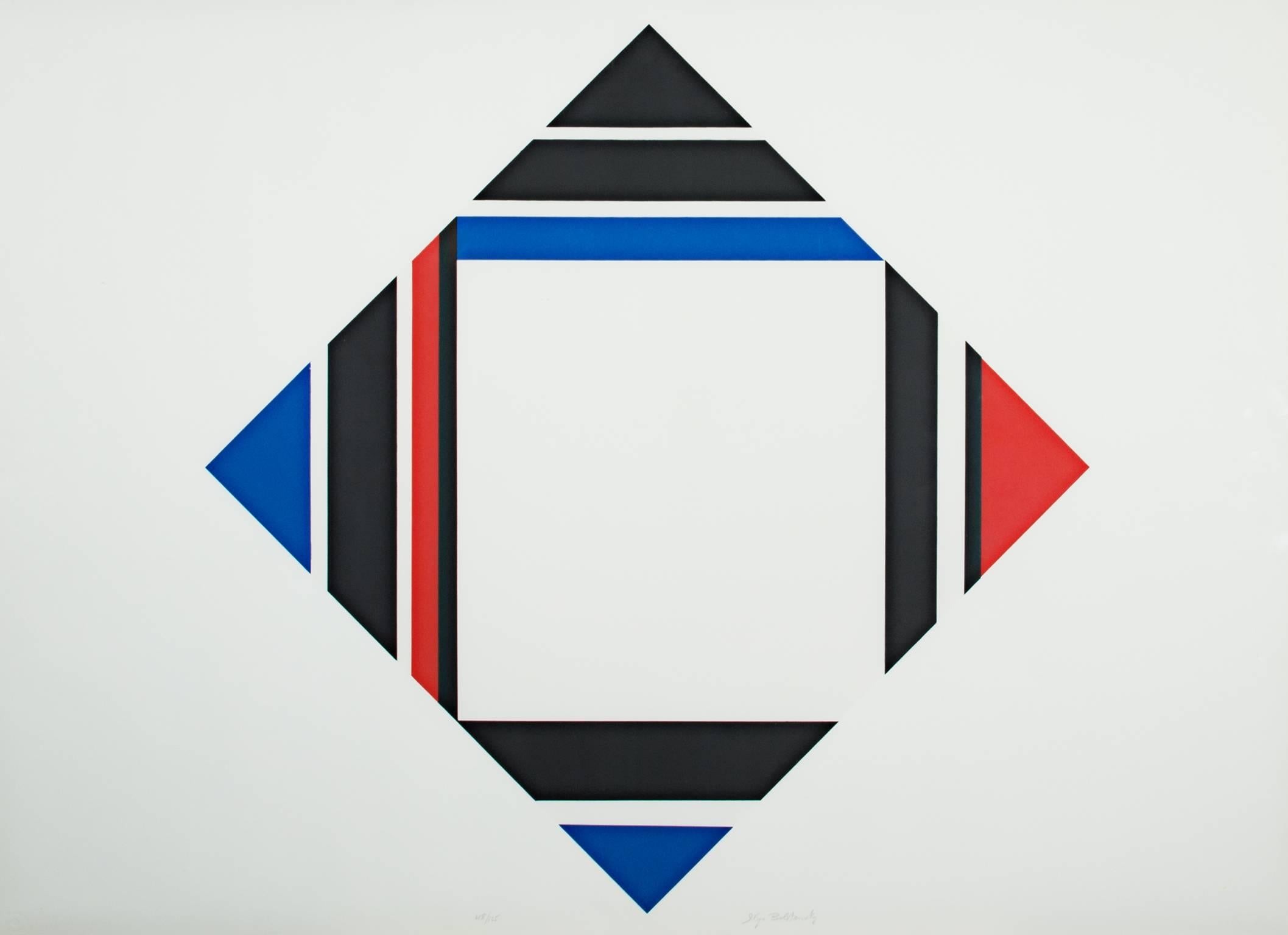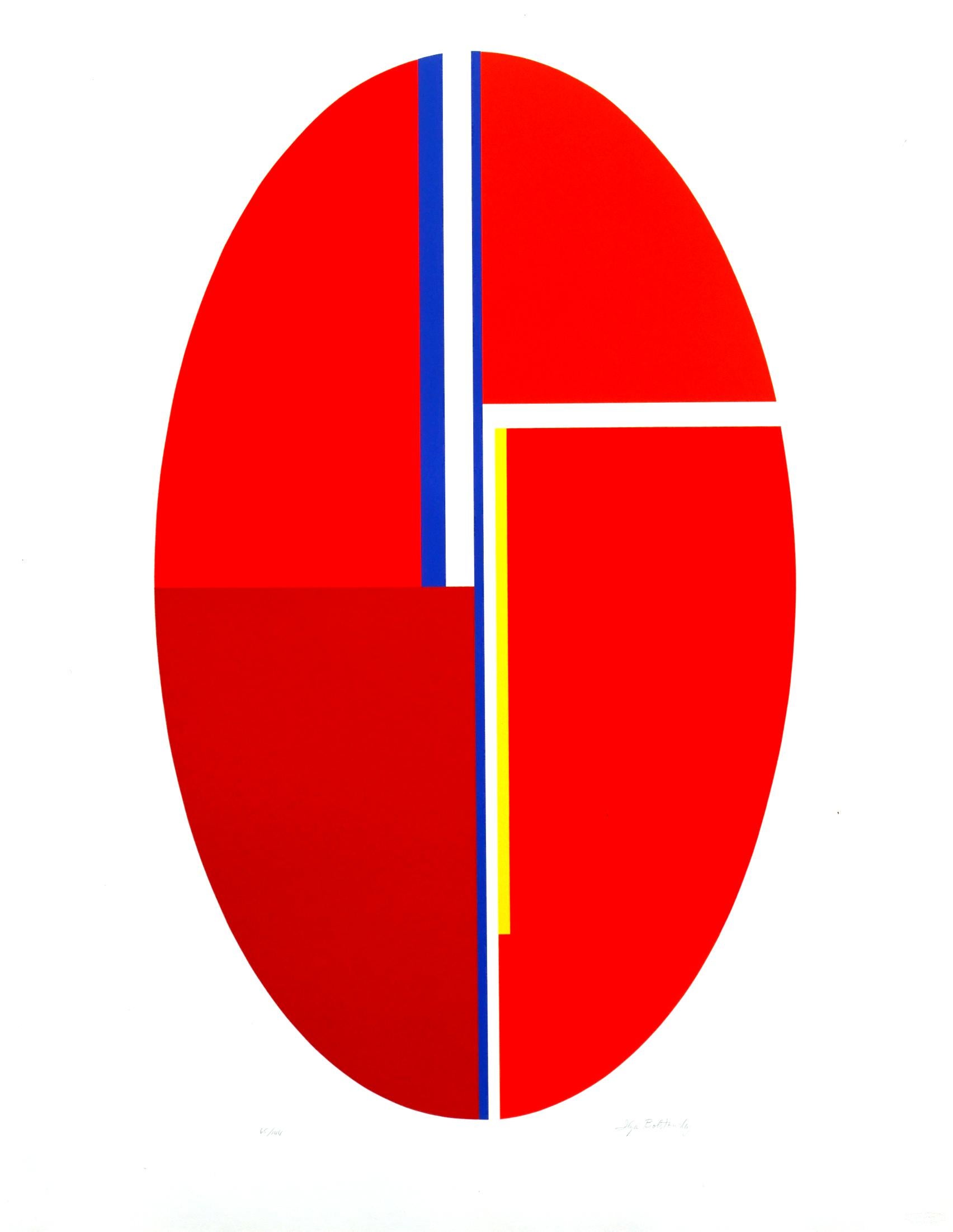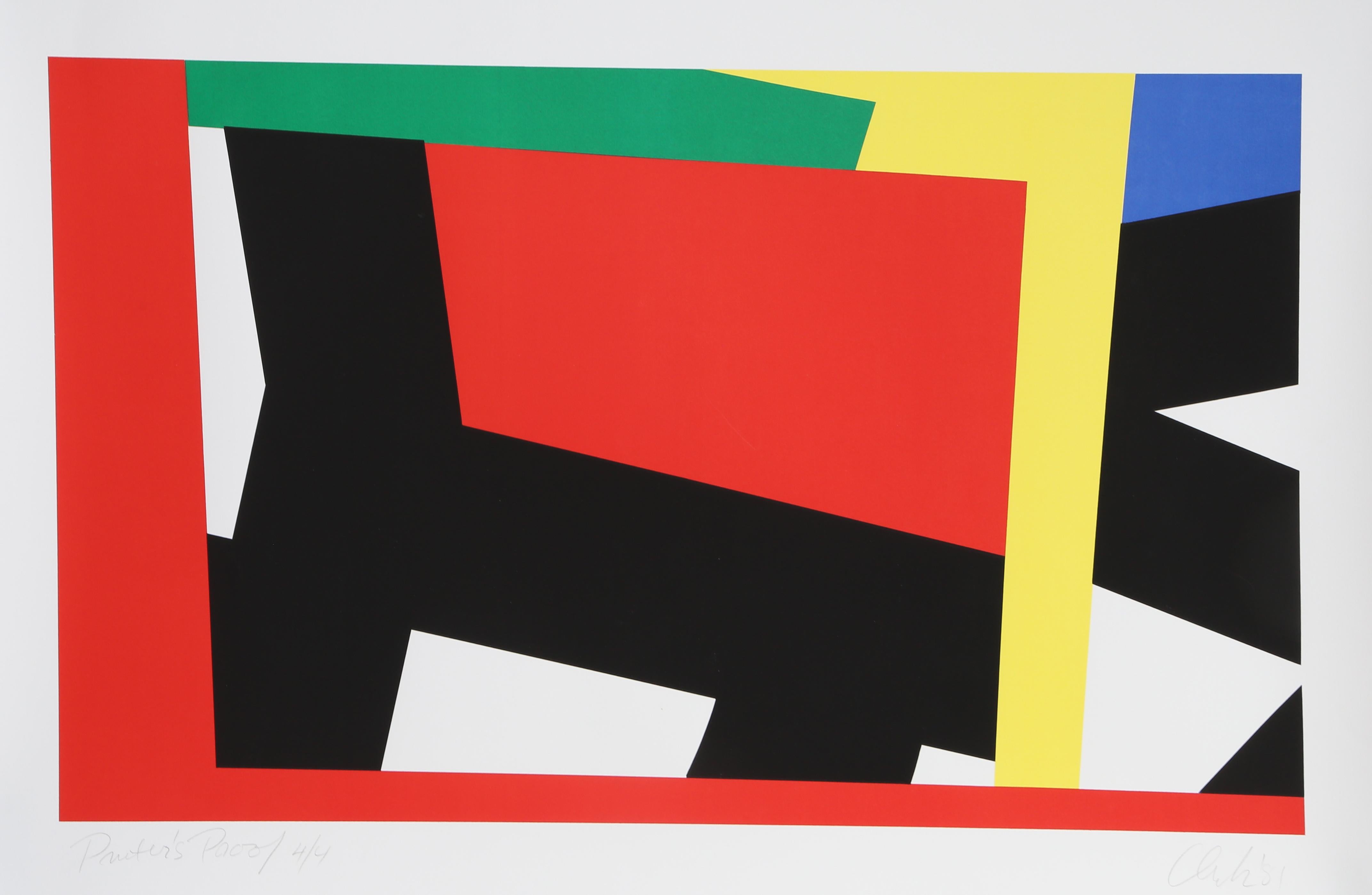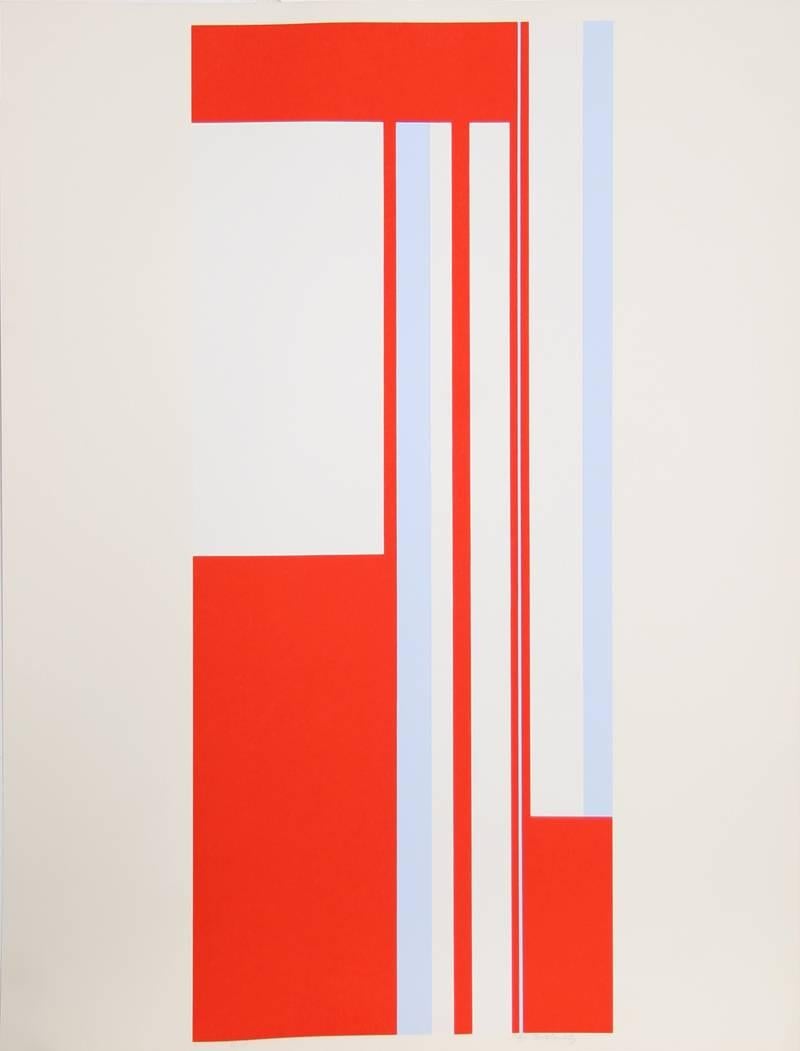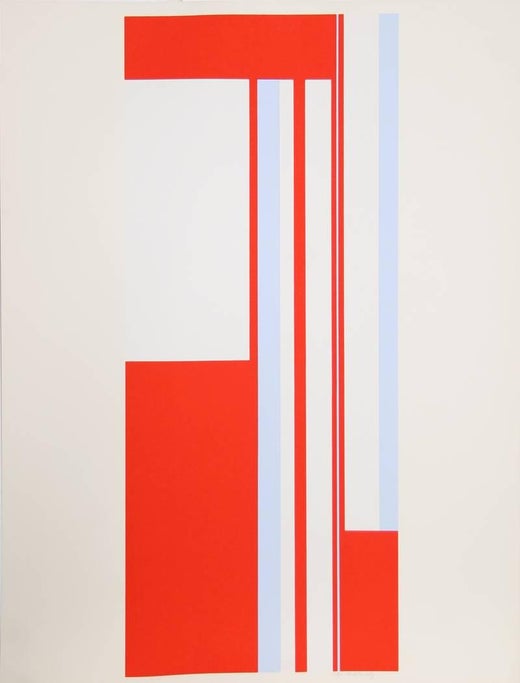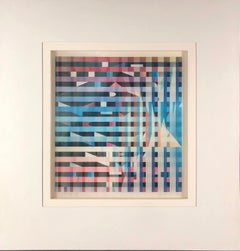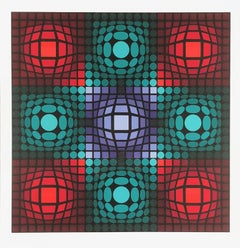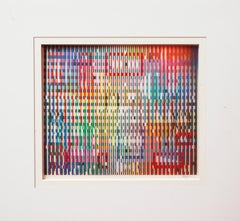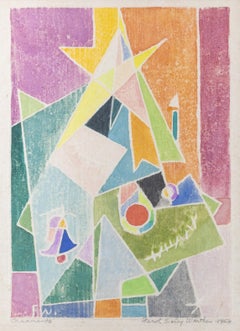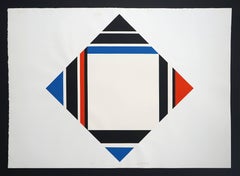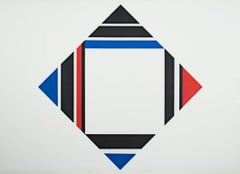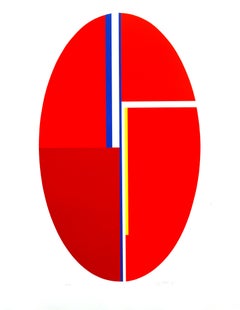Items Similar to Geometric Composition with Red Diamond
Want more images or videos?
Request additional images or videos from the seller
1 of 5
Ilya BolotowskyGeometric Composition with Red Diamond
$1,850
£1,441.51
€1,635.35
CA$2,658.87
A$2,927.67
CHF 1,518.12
MX$34,671.63
NOK 19,271.61
SEK 18,011.50
DKK 12,214.11
About the Item
Signed and Numbered Ed. 125
The following is excerpted from The New York Times, August 6, 2001 by Daniel Watkin:
"Shedding 7 Coats, a Beauty Emerges on a Hospital Wall"
By DANIEL J. WAKIN
For nearly six months, the men of Ward B-11 watched restorers chip and dissolve their way through seven coats of institutional paint. They breathed the mingled odors of solvent and hospital food. They wondered at the stream of important-looking visitors to their day room.
And they witnessed the resurrection of a 1941 landmark of abstract art in America.
It is a mural by the Russian-born artist Ilya Bolotowsky in the circular day room at Goldwater Memorial Hospital on Roosevelt Island. The 350-square- foot assembly of lines, right-angled shapes and pastel colors has undergone a complete restoration, which was completed on Monday.
The mural lay hidden and forgotten for decades, a victim of the passive neglect of bureaucrats, until it was featured in 1991 by the Municipal Arts Society's Adopt-a- Mural program and funding was pieced together for the restoration.
"It's an absolutely wonderful thing," said Andrew Bolotowsky, the artist's son. "My father was very serious about this particular work, as he was about all his works. It was very dear to his heart."
In his lifetime, Bolotowsky, one of the nation's first important abstract painters, knew his mural had been painted over. But he did not speak about it often, his son said. "The things that were most important to him, he was quiet about," Andrew Bolotowsky said.
In 1981, Bolotowsky began reproducing the mural as an acrylic painting, but he died before finishing the canvas. The mural faded from memory. Now it is back, and the tale of its excavation carries a fair number of twists and turns. So did the life of Bolotowsky.
Bolotowsky (boh-loh-TUFF-skee) was born in 1907 in St. Petersburg, the son of a lawyer and an artist. The family fled the Russian Revolution for Constantinople, and immigrated to the United States in 1923. Bolotowsky attended the National Academy of Design in New York, served in the Army as a technical translator in Alaska, made movies, and wrote plays and short stories.
He had a Balkan-style mustache and a photographic memory. He played Bach slowly and romantically on the harpsichord. For exercise as a young man, Bolotowsky would walk from Manhattan to Tarrytown, N.Y., and back. As a father, he would take his son on walks lasting hours to lectures on "anything and everything," Andrew Bolotowsky said.
Bolotowsky was a founder, in 1936, of American Abstract Artists, a group that included Piet Mondrian, Ad Reinhardt and George L. K. Morris. They created purely abstract art in a style that came to be known as Neo-Plasticism.
Like many abstract painters of his time, Bolotowsky is not very well known, said Debra Balken, a historian of American modernist art and independent curator. But scholars and art lovers are beginning to rediscover the period.
"His contribution was keeping alive abstract painting during the decade of the 30's," she said. "It was the decade of the Depression. It was not fashionable to be an abstract painter."
As Bolotowsky was beginning American Abstract Artists, the Federal Works Progress Administration commissioned him to create a mural, one of the first abstract murals in the country, for the Williamsburg Housing Project in Brooklyn.
The W.P.A. also hired him to paint a mural at the hospital, at the time called the Hospital for Chronic Diseases, on what was then called Welfare Island. Bolotowsky was a second choice. (Wiser heads prevailed when the first choice, Byron Browne, proposed a photomontage of vigorous young athletes, perhaps not ideal for a hospital that was built in 1939 for tuberculosis patients.)
"The most suited design for a hospital mural should contain no definite subject matter but should be generally soothing in its line and color," Bolotowsky wrote in his proposal.
In the post-World War II years, institutions lost a taste for government-funded art, particularly abstract works, and many of the hundreds of W.P.A. murals in New York fell on hard times. Bolotowsky's mural was painted over.
Samuel Lehrfeld, the executive director of Goldwater, part of the Coler- Goldwater Specialty Care Hospital and Nursing Facility, has served in some capacity at the hospital since 1972. He said he learned about the mural's existence somewhere on the grounds in the early 1980's. "If we had seen that mural, and if anybody had painted it, there would have been somebody dead here," he proclaimed.
Bolotowsky embarked on his project to recreate the work, plus two others feared lost, in 1979.
A lucky stroke helped. Years earlier, Jackson Pollock came across a scaled- down preliminary version of the mural in a pile of W.P.A. materials, Andrew Bolotowsky said. Pollock retrieved it; his wife, the artist Lee Krasner, later donated it to the Guggenheim Museum. Bolotowsky photographed the scale version to use for his acrylic reproduction.
On a gray November day in 1981, as he was on his way to let in a visitor, Bolotowsky stepped through the manually operated doors of the freight elevator at his Lower Manhattan loft. He was unaware that the elevator was at the ground floor; he plunged down the shaft and died. Andrew Bolotowsky still has the charcoal sketch his father was working on at the time for the central panel of the mural reproduction.
- Creator:Ilya Bolotowsky (1907-1981, American, Russian)
- Dimensions:Height: 30 in (76.2 cm)Width: 22 in (55.88 cm)
- Medium:
- Movement & Style:
- Period:
- Condition:
- Gallery Location:Missouri, MO
- Reference Number:1stDibs: LU74732277871
Ilya Bolotowsky
Ilya Bolotowsky grew up in Russia and enjoyed drawing, but his family wanted him to do something “socially useful,” so he planned to be a lawyer. He changed his mind after he moved to New York, however, and enrolled at the National Academy of Design. During the 1930s, the Works Progress Administration hired him as a mural painter, and he was one of the first artists to create completely abstract designs for the project. He composed geometric images from colored rectangles and squares, inspired by his belief in “ideal harmony and order.” From the late 1940s, Bolotowsky used canvases shaped as diamonds, circles, and ovals to show how the edge of the painting could change the visual effect of the lines and angles within. (Bolotowsky, interviewed by Svendsen and Poser, Ilya Bolotowsky, 1974)
About the Seller
5.0
Vetted Professional Seller
Every seller passes strict standards for authenticity and reliability
Established in 1970
1stDibs seller since 2017
156 sales on 1stDibs
Typical response time: Several days
- ShippingRetrieving quote...Shipping from: Missouri, MO
- Return Policy
More From This Seller
View AllAbstract Composition - Pyramid
By Yaacov Agam
Located in Missouri, MO
Yaacov Agam
"Abstract Composition"
Agamograph
Ed. 87/99
Signed and Numbered
Site Size: approx 16 x 13 inches
Framed: approx. 24.5 x 22.5 inches
An agamograph is a series of images ...
Category
Late 20th Century Modern Abstract Prints
Materials
Screen
Price Upon Request
Red and Green Bubbles
By Victor Vasarely
Located in Missouri, MO
Victor Vasarely
"Red and Green Bubbles" c. 1970
Color Serigraph
Signed and Numbered Ed. 125
Framed Size: 34 x 29.5 inches
Image: approx 18 x 18 inches
Category
1970s Abstract Geometric Abstract Prints
Materials
Lithograph
Price Upon Request
Abstract Composition
By Yaacov Agam
Located in Missouri, MO
Yaacov Agam
"Abstract Composition"
Agamograph
Ed. 17/25
Signed and Numbered
Site Size: approx 13 x 16 inches
Framed: approx. 22.5 x 24.5 inches
An agamograph is a series of images ...
Category
Late 20th Century Modern Abstract Prints
Materials
Screen
Price Upon Request
Ornaments
Located in Missouri, MO
Ornaments, 1953
Ferol K. Sibley Warthen (American, 1890-1986)
Color Woodblock Print
7 x 4.75 inches
16 x 13.75 inches with frame
Signed and Dated Lower Right
Titled Lower Left
Born 1890, Died 1986...
Category
1950s American Modern Abstract Prints
Materials
Color
Abstract (Edition 75/100)
By Bram Van Velde
Located in Missouri, MO
Abstract (Edition 75/100)
By Bram Van Velde (1895-1981)
Numbered Lower Left
Signed Lower Center
Unframed: 25" x 28"
Framed: 31.5" x 34.5"
Bram (Abraham Gerardus) van Velde was a Dutch painter known for an intensely colored and geometric semi-representational painting style related to Tachisme*, and Lyrical Abstraction*. He is often seen as member of the School of Paris* but his work resides somewhere between expressionism* and surrealism*, and evolved in the 1960s into an expressive abstract art. His paintings from the 1950s are similar to the contemporary work of Matisse, Picasso and the abstract expressionist Adolph Gottlieb. He was championed by a number of French-speaking writers, including Samuel Beckett and the poet André du...
Category
20th Century Abstract Abstract Prints
Materials
Lithograph
Price Upon Request
Angel
Located in Missouri, MO
Angel, 1952
Ferol K. Sibley Warthen (American, 1890-1986)
Color Woodblock Print
6.5 x 5 inches
16 x 13.75 inches with frame
Signed Lower Right
Titled Lower Left
Born 1890, Died 1986...
Category
1950s American Modern Abstract Prints
Materials
Color
You May Also Like
Red/Blue/Black Diamond
By Ilya Bolotowsky
Located in Austin, TX
Artist: Ilya Bolotowsky
Title: Red/Blue/Black Diamond
Year: 1970
Dimensions: 25.75 in x 35.875 in
Signed lower right
Edition: 30/125
Gondition: Good. 4 small square spots on top of w...
Category
1970s Abstract Geometric Abstract Prints
Materials
Screen
"Red/Blue/Black Diamond" Silkscreen Print signed by Ilya Bolotowsky
By Ilya Bolotowsky
Located in Milwaukee, WI
Ilya Bolotowsky's Red/Blue/Black Diamond from around 1970, immediately shows the deep influence of Piet Mondrian's New-Plasticism. Bolotowsky first saw Mondrian's paintings in the 19...
Category
1970s Abstract Geometric Abstract Prints
Materials
Screen
Untitled
By Ilya Bolotowsky
Located in New York, NY
b. 1907, St. Petersburg, Russia – d. 1981
Bolotowsky respected the principles of the De Stijl style and was influenced by the artist, Piet Mondrian. Bolotowsky incorporated geometri...
Category
1980s Abstract Geometric Abstract Prints
Materials
Screen
Untitled
By Ilya Bolotowsky
Located in New York, NY
b. 1907, St. Petersburg, Russia – d. 1981
Bolotowsky respected the principles of the De Stijl style and was influenced by the artist, Piet Mondrian. Bolotowsky incorporated geometri...
Category
1980s Abstract Geometric Abstract Prints
Materials
Screen
Red, Geometric Abstract Screenprint by Pierre Clerk 1981
Located in Long Island City, NY
Artist: Pierre Clerk, American (1928 - )
Title: Red
Year: 1981
Medium: Silkscreen on BFK Rives, signed and numbered in pencil
Edition: PP 4/4
Image Size: ...
Category
1980s Abstract Geometric Abstract Prints
Materials
Paper, Screen
Series 1, Geometric Abstract Screenprint by Bolotowsky
By Ilya Bolotowsky
Located in Long Island City, NY
A silkscreen print by Ilya Bolotowsky circa 1970. A retro modern piece with an abstract geometric design.
Artist: Ilya Bolotowsky, Russian/American (1907 - 1981)
Title: Series 1
Ye...
Category
1970s Abstract Geometric Abstract Prints
Materials
Screen
